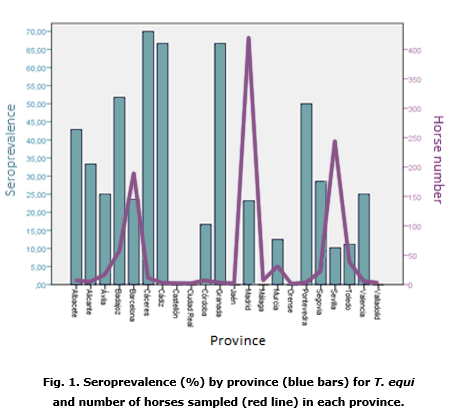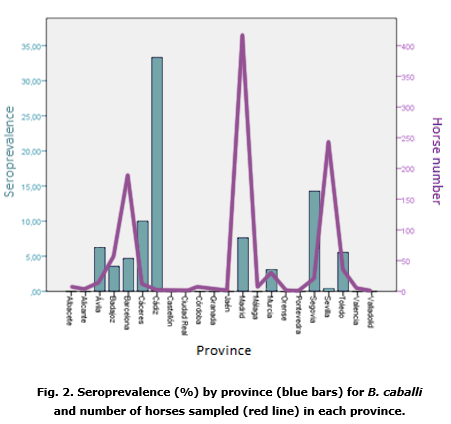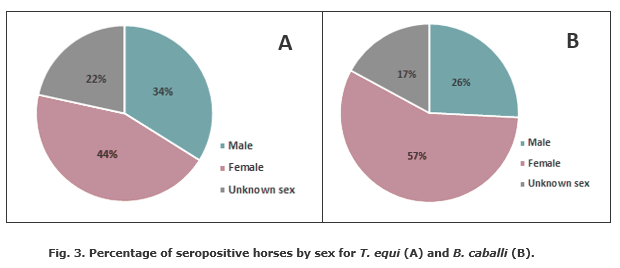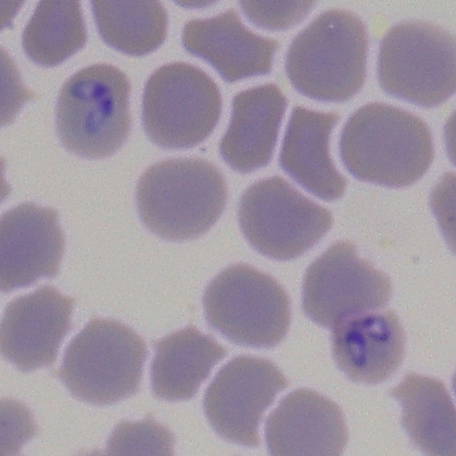Equine piroplasmosis seroprevalence in spanish horses prior to exportation
Eliazar Camino, Kelly Alejandra Carvajal, Francisco Javier Lozano, Cristina Viñolo, Lucas Domínguez Rodríguez and Fátima Cruz
Equine Piroplasmosis (EP) is an infectious disease of equids caused by the intraerythrocytic parasites Babesia caballi and/or Theileria equi, transmitted by ixodid ticks from the Dermacentor, Hyalomma and Rhipicephalus genera. Once horses have overcome the infection, they can remain as asymptomatic carriers of these parasites for long periods of time (B. caballi) or even life-long (T. equi) being a sourse of infection for tick vectors. This makes EP the main restriction for the international movement of equids from endemic countries, such as Spain, to countries free from EP, which involves huge economic losses for the equine sector.
EP can be hyperacute (multiorganic failure and death), acute, subacute or chronic, including variable and unespecific clinical signs such as fever, inappetence, pale mucoses, icterus, weight loss and exercise intolerance. The serological test of Complement Fixation test was used until 2005 for the diagnosis of EP in horses prior to exportation. Since then, this technique has been replaced by the competition ELISA (cELISA) due to the latter being considered as more sensitive for the diagnosis of chronic infections or carrier horses.


Up to present there are no studies regarding the impact of EP on the exportation of horses from Spain. The aim of this study was to obtain the first EP seroprevalence data in horse samples received from different areas of the country for their informative analysis prior to exportation.
In this study serum samples from 1067 horses residing in different provinces in Spain were analysed. The samples were received from August 2015 to August 2016, included 517 male horses, 316 mares and 234 samples from horses with unknown sex) and were tested using two commercial diagnostic kits: Babesia equi Antibody Test Kit and Babesia caballi Antibody Test Kit (VMRD, Pullman), in order to detect immunoglobulins type G against these parasites. For each sample, the inhibition percentage was calculated and only the samples with a percentage overo or equal to 40% were considered positive.
The statistical analysis of data was carried out by using a Chi-square test with STATA versión 12.0.
From the 1067 horses tested, a total of 234 (21.9%; 95% IC 19.5-24.5) and 53 (5.0%; 95 IC 3.7-6.4) were positive for T. equi and B. caballi, respectively. Furthermore, 29 horses (2.7%; 95% IC 1.7-3.7) were seropositive for both parasites. The highest exposure to T. equi was found in Cáceres (70.0%), Cádiz and Granada (66.7%) (Figure 1), whereas the provinces with higher seroprevalence for B. caballi were Cádiz (33.3%), Segovia (14.3%) and Cáceres (10.0%) (Figure 2).
The analysis of seroprevalence by sex showed that female horses (mares) presented a significantly higher seroprevalence than male horses for both T. equi (p=0.026) and B. caballi (p=0.006) (Figure 3).

This fact can be explained by the different management of male and female horses from 2 years-old; mares remain in the fields, while male horses are confined in stables for training and sales or to avoid undesired coverings; therefore they stop having exposure to ticks.
The results of this study demonstrate that there is a high exposure of horses to EP in Spain, with variations between the different provinces. Similarly to other endemic countries, exposure to T. equi is higher than that for B. caballi (22% vs. 5%). According to our results, nearly 25% of horses tested prior to exportation won´t be able to travel, which confirms the great negative impact of EP on the Spanish equine sector, not only due to the economic losses associated to the impossibility of exportation, but also due to the investment on the breeding and training of these horses. The application of appropriate measures such as the use of acaricidal products and the daily review of horses will aid to reduce the number of EP positive cases.
Equine Health Surveillance Unit
VISAVET Health Surveillance Centre
Complutense University Madrid (Spain)
Tel.: (+34) 913944096
seviseq@ucm.es
Bibliography
- Anon. 2010. Piroplasmosis equina. The Center for Food Security and Public Health and Institute for International Cooperation in Animal Biologics, Iowa State University.. 167(1-2): 50-60.
- Anon. 2013. Estudio del Impacto del Sector Ecuestre en España. Real Federación Hípica Española.
- Anon. 2014. Equine piroplasmosis. OIE Manual of Diagnostic Tests and Vaccines for Terrestrial Animals. Chapter 2.5.8.
- Bruning A. et al 1996. Equine piroplasmosis an update on diagnosis, treatment and prevention. Br Vet J. 152(2):139-51.
- Camacho, A.T. et al 2005. Theileria (Babesia) equi and Babesia caballi infections in horses in Galicia, Spain. Trop Anim Health Pro 37, 293-302.
- Elisa, B.D.L. et al 2016. Babesia caballi and Theileria equi infections in horses in Central-Southern Italy: Sero-molecular survey and associated risk factors. Ticks Tick-Borne Dis. 7, 462-469.
- Garcia-Bocanegra, I. et al 2013. Seroprevalence and risk factors associated with Babesia caballi and Theileria equi infection in equids. Vet J 195, 172-178.
- Knowles, D.P. et al 1992. Antibody to a recombinant merozoite protein epitope identifies horses infected with Babesia equi. J Clin Microbiol 30,3122-3126.
- Ueti, M.W. et al 2008. Persistently infected horses are reservoirs for intrastadial tick-borne transmission of the apicomplexan parasite Babesia equi. Infect Immun 76,3525-3529.
- Weiland, G. et al 1986. Species-specific serodiagnosis of equine piroplasma infections by means of complement fixation test (CFT), immunofluorescence (IIF), and enzyme-linked immunosorbent assay (ELISA). Vet Parasitol 20,43-48.
- Wise LN. et al 2013. Review of equine piroplasmosis. J Vet Intern Med. 27(6):1334-46.
- Wise LN. et al. 2014. Equine piroplasmosis. Vet Clin North Am Equine Pract. 30(3):677-93.
- Zobba R. et al. 2008. Clinical and laboratory findings in equine piroplasmosis. J Equine Vet Sci. 28(5):301-8.









